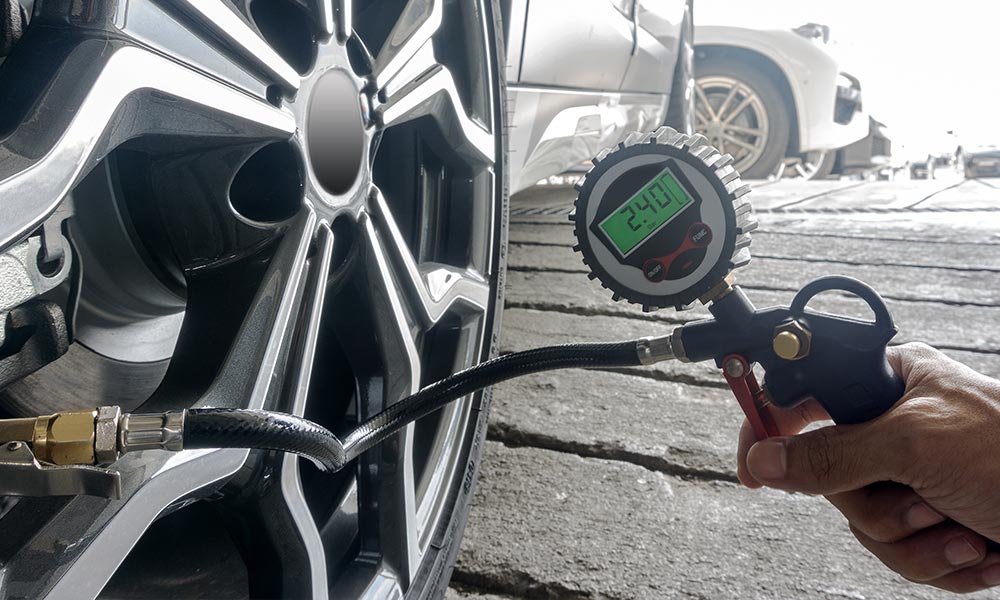When it comes to tire maintenance, tire pressure is like the porridge in Goldilocks and the Three Bears. Every tire has a PSI (Pound Per Square Inch) rating for how much air it takes to fill it to the “sweet spot.” Too much air (over inflation) can be just as bad as not enough (under inflation). This delicate balancing act means drivers should be checking their PSI monthly to ensure each tire stays at the optimal level.
But why is this balancing act so important? As long as your tire isn’t flat, it’s ok, right?
Wrong.
Having a tire that’s improperly inflated (both under or over) can lead to serious damage to your tire and ultimately, your overall driving performance. Driving with under or over-inflated tires decreases fuel efficiency, causes uneven and premature wear on your tire, and affects your steering and alignment. To get your money’s worth and give your tire a longer lifespan, check your tire pressure regularly.
Here are the basics every driver needs to know about tire pressure and how to keep it in the perfect Goldilocks approved ‘sweet spot’.
TPMS Warning Light
Your first introduction with tire pressure might be when your TPMS warning light illuminates on your dashboard. This light looks like a horseshoe-shaped light with an exclamation point in the center. TPMS stands for Tire Pressure Monitoring System. It shows when the tire pressure is too low and needs to be checked.
But, if there’s a system already built in to monitor my tire pressure, why do I need to check it every month?
The TPMS is there to let you know your tires are low. By the time the light is on, that means there’s a problem that needs to be addressed immediately. Doing routine maintenance helps prevent that light from coming on. The TPMS is a helpful tool, but it’s not a replacement for routine maintenance.
Where Can You Find the Recommended PSI?
The first thing you need to figure out is what your Goldilocks PSI is. PSI varies depending on the vehicle. You can either find your PSI on the sticker inside the driver’s door or in the owner’s manual. Knowing this number will make it easier for you when you do check your tire pressure to ensure you’re within the proper safety zone.
What Affects Tire Pressure?
Sudden Changes in Weather/Ambient Temperature
Temperature changes can greatly affect your tire pressure, which is why during season changes, it’s important to keep an eye on your tire PSI. Warm weather can cause the air in your tire to expand, and cold weather causes it to contract. When the weather drastically shifts in either direction, your tire pressure changes. This fluctuation happens throughout the day as well as through the season, with tire pressure going up during warmer hours and dropping during cooler hours. Even a 15-degree change can cause tire pressure to fluctuate by as much as 10%.Driving Habits
How you drive can affect your tire pressure as well. Constantly driving at high speeds can put unnecessary stress on the tires. Increased friction from the road against the rubber of your tires causes the temperature within them to rise, increasing tire pressure. Hauling extremely heavy loads over long distances can also trigger tire pressure fluctuations that can weaken your tires and cause them to deflate. Repeated sudden braking is also hard on your tires. While the occasional emergency stop may be required for safety reasons, try not to make slamming on your brakes at every red light a habit.Lodged Debris
Tire tread may be great for giving you traction, but it can also be a spot for debris to lodge. Having debris lodged in your tread can eventually lead to decreased tire pressure as the object can wear through the rubber and cause a slow leak, or in some cases, lead to a direct puncture. Check your tires often for pieces of debris and clean them out before they become an issue.How To Check Your Tire Pressure
Different Tire Pressure Gauges
Standard Gauge
This gauge is also known as the pencil gauge. They are simple and compact to fit nicely in your glove compartment. However, they might be a little harder to interpret than a digital gauge.

Digital Gauge
Digital gauges are easier to use than the standard gage. Having the LCD display makes it easy to check your tire pressure at a glance, including at night. The only drawback to the digital gauge is the fact that you do need to make sure the batteries are fresh. Having a backup standard gauge in your car is always a good idea.

Checking Your Tire Pressure
Follow these steps when checking your tire pressure:
- Remove the cap from the air valve on the tire and put it somewhere you won’t lose it.
- Press the tire gauge against the open valve stems for a second or two. It’s normal to hear the hiss of air.
- Read the pressure gauge.
- Compare the gauges number with the recommended tire pressure.
- If your tires are properly inflated, replace the tire’s air valve cap.
- Then repeat this process for each tire.
- If you need to inflate your tires, stop by your local Commercial Tire for a top off.
Conclusion
Every driver should know the basics of tire pressure to establish the habit of inspecting and gauging their tire. If you have questions about your tire’s PSI, recommended gauges, or simply need a top off for your tire air, visit your local Commercial Tire and talk with a professional.
